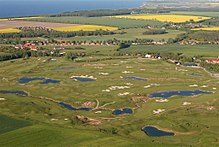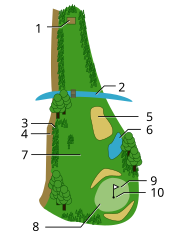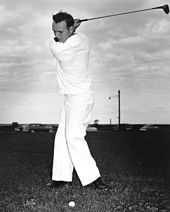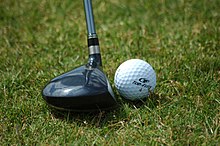
It is one of the few ball games that do not require a standardized playing area. Instead, the game is played on a course, in general consisting of an arranged progression of either nine or 18 holes. Each hole on the course must contain a tee box to start from, and a putting green containing the actual hole. There are various other standardized forms of terrain in between, such as the fairway, rough, and hazards, but each hole on a course, and indeed among virtually all courses, is unique in its specific layout and arrangement.
Golf competition is generally played for the lowest number of strokes by an individual, known simply as stroke play, or the lowest score on the most individual holes during a complete round by an individual or team, known as match play. Stroke play is the most commonly seen format at virtually all levels of play, although variations of match play, such as "skins" games, are also seen in televised events. Other forms of scoring also exist.
Origin
While the modern game of golf originated in 15th-century Scotland, the game's ancient origins are unclear and much debated. Some historians trace the sport back to the Roman game of paganica, in which participants used a bent stick to hit a stuffed leather ball. One theory asserts that paganica spread throughout Europe as the Romans conquered most of the continent, during the first century BC, and eventually evolved into the modern game. Others cite chuiwan ("chui" means striking and "wan" means small ball) as the progenitor, a Chinese game played between the eighth and 14th centuries. A Ming Dynasty scroll dating back to 1368 entitled "The Autumn Banquet" shows a member of the Chinese Imperial court swinging what appears to be a golf club at a small ball with the aim of sinking it into a hole. The game is thought to have been introduced into Europe during the Middle Ages. Another early game that resembled modern golf was known as cambuca in England and chambot in France. The Persian game chaugán is another possible ancient origin. In addition, kolven (a game involving a ball and curved bats) was played annually in Loenen, Netherlands, beginning in 1297, to commemorate the capture of the assassin of Floris V, a year earlier.The modern game originated in Scotland, where the first written record of golf is James II's banning of the game in 1457, as an unwelcome distraction to learning archery. James IV lifted the ban in 1502 when he became a golfer himself, with golf clubs first recorded in 1503-1504: "For golf clubbes and balles to the King that he playit with". To many golfers, the Old Course at St Andrews, a links course dating to before 1574, is considered to be a site of pilgrimage. In 1764, the standard 18 hole golf course was created at St Andrews when members modified the course from 22 to 18 holes. Golf is documented as being played on Musselburgh Links, East Lothian, Scotland as early as 2 March 1672, which is certified as the oldest golf course in the world by Guinness World Records. The oldest surviving rules of golf were compiled in March 1744 for the Company of Gentlemen Golfers, later renamed The Honourable Company of Edinburgh Golfers, which was played at Leith, Scotland. The world's oldest golf tournament in existence, and golf's first major, is The Open Championship, which was first played on 17 October 1860 at Prestwick Golf Club, in Ayrshire, Scotland, with Scottish golfers winning the earliest majors. Two Scotsmen from Dunfermline, John Reid and Robert Lockhart, first demonstrated golf in the US by setting up a hole in an orchard in 1888, with Reid setting up America's first golf club the same year, St. Andrews Golf Club in Yonkers, New York.
Golf course

Aerial view of the Golfplatz Wittenbeck in Mecklenburg,
Germany
The levels of grass are varied to increase difficulty, or to allow for putting in the case of the green. While many holes are designed with a direct line-of-sight from the teeing area to the green, some holes may bend either to the left or to the right. This is commonly called a "dogleg", in reference to a dog's knee. The hole is called a "dogleg left" if the hole angles leftwards and "dogleg right" if it bends right. Sometimes, a hole's direction may bend twice; this is called a "double dogleg".
A typical golf course consists of 18 holes, but nine-hole courses are common and can be played twice through for a full round of 18 holes.
Early Scottish golf courses were primarily laid out on links land, soil-covered sand dunes directly inland from beaches. This gave rise to the term "golf links", particularly applied to seaside courses and those built on naturally sandy soil inland.
The first 18-hole golf course in the United States was on a sheep farm in Downers Grove, Illinois, in 1892. The course is still there today.
Play of the game

1=teeing ground, 2=water hazard, 3=rough, 4=out of bounds,
5=sand bunker, 6=water hazard, 7=fairway, 8=putting green, 9=flagstick, 10=hole
Playing a hole on a golf course is initiated by putting a ball into play by striking it with a club on the teeing ground (also called the tee box, or simply the tee). For this first shot on each hole, it is allowed but not required for the golfer to place the ball on a tee prior to striking it. A tee in this last sense is a small peg that can be used to elevate the ball slightly above the ground up to a few centimetres high, which reduces the interference of the ground or grass on the movement of the club making the ball easier to hit, and also places the ball in the very center of the striking face of the club (the "sweet spot") for better distance. Tees are commonly made of wood but may be constructed of any material, including plastic. Traditionally, golfers used mounds of sand to elevate the ball, and containers of sand were provided for the purpose. A few courses still require sand to be used instead of peg tees, to reduce litter and reduce damage to the teeing ground.
When the initial shot on a hole is intended to move the ball a long distance (typically more than 225 yards (206 m)), the shot is commonly called a "drive" and is generally made with a long-shafted, large-headed wood club called a "driver". Shorter holes may be initiated with other clubs, such as higher-numbered woods or irons. Once the ball comes to rest, the golfer strikes it again as many times as necessary using shots that are variously known as a "lay-up", an "approach", a "pitch", or a "chip", until the ball reaches the green, where he or she then "putts" the ball into the hole (commonly called "sinking the putt" or "holing out"). The goal of getting the ball into the hole ("holing" the ball) in as few strokes as possible may be impeded by obstacles such as areas of longer grass called "rough" (usually found alongside fairways), which both slows any ball that contacts it and makes it harder to advance a ball that has stopped on it; "doglegs", which are changes in the direction of the fairway that often require shorter shots to play around them; bunkers (or sand traps); and water hazards such as ponds or streams.
In stroke play competitions played according to strict rules, each player plays his or her ball until it is holed no matter how many strokes that may take, but in match play it is acceptable to simply pick up one's ball and "surrender the hole" after enough strokes have been made by a player that it is mathematically impossible for the player to win the hole. It is also acceptable in informal stroke play to surrender the hole after hitting three strokes more than the "par" rating of the hole (a "triple bogey" - see below); while technically a violation of Rule 3-2, this practice speeds play as a courtesy to others, and avoids "runaway scores", excessive frustration and injuries caused by overexertion.
The total distance from the first tee box to the 18th green can be quite long; total yardages "through the green" can be in excess of 7000 yards, and when adding in the travel distance between the green of one hole and the tee of the next, even skilled players may easily travel five miles or more during a round. At some courses, electric golf carts are used to travel between shots, which can speed-up play and allows participation by individuals unable to walk a whole round. On other courses players generally walk the course, either carrying their bag using a shoulder strap or using a "golf trolley" for their bag. These trolleys may or may not be battery assisted. At many amateur tournaments including U.S. high school and college play, players are required to walk and to carry their own bags, but at the professional and top amateur level, as well as at high-level private clubs, players may be accompanied by caddies, who carry and manage the players' equipment and who are allowed by the rules to give advice on the play of the course. A caddy's advice can only be given to the player or players for whom the caddy is working, and not to other competing players.
Rules and regulations

Arnold Palmer in 1953
The rules of golf are internationally standardised and are jointly governed
by The R&A, spun off in 2004 from The Royal and Ancient Golf Club of St
Andrews (founded 1754), and the United States Golf Association (USGA).The underlying principle of the rules is fairness. As stated on the back cover of the official rule book:
Play the ball as it lies, play
the course as you find it, and if you cannot do either, do what is fair.
There are strict regulations regarding the amateur status of golfers.
Essentially, anybody who has ever received payment or compensation for giving
instruction, or played golf for money, is not considered an amateur and may not
participate in competitions limited solely to amateurs. However, amateur
golfers may receive expenses that comply with strict guidelines and they may
accept non-cash prizes within the limits established by the Rules of Amateur
Status.In addition to the officially printed rules, golfers also abide by a set of guidelines called golf etiquette. Etiquette guidelines cover matters such as safety, fairness, pace of play, and a player's obligation to contribute to the care of the course. Though there are no penalties for breach of etiquette rules, players generally follow the rules of golf etiquette in an effort to improve everyone's playing experience.
Penalties
Penalties are incurred in certain situations. They are counted towards a player's score as if there were extra swing(s) at the ball. Strokes are added for rule infractions or for hitting one's ball into an unplayable situation.A lost ball or a ball hit out of bounds result in a penalty of one stroke and distance (Rule 27–1). A one-stroke penalty is assessed if a player's equipment causes the ball to move or the removal of a loose impediment causes the ball to move (Rule 18–2). If a golfer makes a stroke at the wrong ball (Rule 19–2) or hits a fellow golfer's ball with a putt (Rule 19–5), the player incurs a two-stroke penalty. Most rule infractions lead to stroke penalties but also can lead to disqualification. Disqualification could be from cheating, signing for a lower score, or from rule infractions that lead to improper play.
Equipment

A wood positioned ready to be swung and to strike a golf
ball
Golf clubs are used to hit the golf ball. Each club is composed of a shaft with a lance (or "grip") on the top end and a club head on the bottom. Long clubs, which have a lower amount of degreed loft, are those meant to propel the ball a comparatively longer distance, and short clubs a higher degree of loft and a comparatively shorter distance. Typically, the actual physical length of each club is longer or shorter, depending on the distance the club is intended to propel the ball.
Golf clubs have traditionally been arranged into three basic types. Woods are large-headed, long-shafted clubs meant to propel the ball a long distance from relatively "open" lies, such as the tee box and fairway. Of particular importance is the driver or "1-wood", which is the lowest lofted wood club, and in modern times has become highly specialized for making extremely long-distance tee shots, up to 300 yards (270 m) or more in the hands of a professional golfer. Traditionally these clubs had heads made of a hardwood, hence the name, but virtually all modern woods are now made of metal such as titanium, or of composite materials. Irons are shorter-shafted clubs with a metal head primarily consisting of a flat, angled striking face. Traditionally the clubhead was forged from iron; modern iron clubheads are investment-cast from a steel alloy. Irons of varying loft are used for a variety of shots from virtually anywhere on the course, but most often for shorter-distance shots approaching the green, or to get the ball out of tricky lies such as sand traps. The third class is the putter, which evolved from the irons to create a low-lofted, balanced club designed to roll the ball along the green and into the hole. Putters are virtually always used on the green or in the surrounding rough/fringe. A fourth class, called hybrids, evolved as a cross between woods and irons, and are typically seen replacing the low-lofted irons with a club that provides similar distance, but a higher launch angle and a more forgiving nature.
A maximum of 14 clubs is allowed in a player's bag at one time during a stipulated round. The choice of clubs is at the golfer's discretion, although every club must be constructed in accordance with parameters outlined in the rules. (Clubs that meet these parameters are usually called "conforming".) Violation of these rules can result in disqualification.
The exact shot hit at any given time on a golf course, and which club is used to accomplish the shot, are always completely at the discretion of the golfer; in other words, there is no restriction whatsoever on which club a golfer may or may not use at any time for any shot.
Golf balls are spherical, usually white (although other colors are allowed), and minutely pock-marked by dimples that decrease aerodynamic drag by increasing air turbulence around the ball in motion, which delays "boundary layer" separation and reduces the drag-inducing "wake" behind the ball, thereby allowing the ball to fly farther.
A tee is allowed only for the first stroke on each hole, unless the player must hit a provisional tee shot or replay his or her first shot from the tee.
Many golfers wear golf shoes with metal or plastic spikes designed to increase traction, thus allowing for longer and more accurate shots. A golf bag is used to transport golf clubs and the player's other or personal equipment. Golf bags have several pockets designed for carrying equipment and supplies such as tees, balls, and gloves. Golf bags can be carried, pulled on a trolley or harnessed to a motorized golf cart during play. Golf bags have both a hand strap and shoulder strap for carrying, and sometimes have retractable legs that allow the bag to stand upright when at rest.
Stroke mechanics

A golfer takes an approach shot on the fairway.
The golf swing is outwardly similar to many other motions involving swinging a tool or playing implement, such as an axe or a baseball bat; however, unlike many of these motions, the result of the swing is highly dependent on several sub-motions being properly aligned and timed, to ensure that the club travels up to the ball in line with the desired path, the clubface is in line with the swing path, and the ball impacts the center or "sweet spot" of the clubface. The ability to do this consistently, across a complete set of clubs with a wide range of shaft lengths and clubface areas, is a key skill for any golfer, and takes a significant effort to achieve.
Golfers start with the non-dominant side of the body facing the target (for a right-hander, the target is to their left). At address, the player's body and the centerline of the club face are positioned parallel to the desired line of travel, with the feet either perpendicular to that line or slightly splayed outward. The feet are commonly shoulder-width apart for middle irons and putters, narrower for short irons and wider for long irons and woods. The ball is typically positioned more to the "front" of the player's stance (closer to the leading foot) for lower-lofted clubs, with the usual ball position for a drive being just behind the arch of the leading foot. The ball is placed further "back" in the player's stance (toward the trailing foot) as the loft of the club to be used increases. Most iron shots and putts are made with the ball roughly centered in the stance, while a few mid- and short-iron shots are made with the ball slightly behind the center of the stance to ensure consistent contact between the ball and clubface, so the ball is on its way before the club continues down into the turf.
The golfer chooses a golf club, grip, and stroke appropriate to the distance:
- The "drive" or "full swing" is used on the teeing ground and fairway, typically with a wood or long iron, to produce the maximum distance capable with the club. In the extreme, the windup can end with the shaft of the club parallel to the ground above the player's shoulders.
- The "approach" or "3/4 swing" is used in medium- and long-distance situations where an exact distance and good accuracy is preferable to maximum possible distance, such as to place the ball on the green or "lay up" in front of a hazard. The windup or "backswing" of such a shot typically ends up with the shaft of the club pointing straight upwards or slightly towards the player.
- The "chip" or "half-swing" is used for relatively short-distance shots near the green, with high-lofted irons and wedges. The goal of the chip is to land the ball safely on the green, allowing it to roll out towards the hole. It can also be used from other places to accurately position the ball into a more advantageous lie. The backswing typically ends with the head of the club between hip and head height.
- The "putt" is used in short-distance shots on or near the green, typically made with the eponymous "putter", although similar strokes can be made with medium to high-numbered irons to carry a short distance in the air and then roll (a "bump and run"). the backswing and follow-through of the putt are both abbreviated compared to other strokes, with the head of the club rarely rising above the knee. The goal of the putt is usually to put the ball in the hole, although a long-distance putt may be called a "lag" and is made with the primary intention of simply closing distance to the hole or otherwise placing the ball advantageously.
Accuracy and consistency is typically stressed over pure distance. A player with a straight drive that travels only 220 yards (200 m) will nevertheless be able to accurately place the ball into a favorable lie on the fairway, and can make up for the lesser distance of any given club by simply using "more club" (a lower loft) on their tee shot or on subsequent fairway and approach shots. However, a golfer with a drive that may go 280 yards (260 m) but often doesn't fly straight will be less able to position their ball advantageously; the ball may "hook", "pull", "draw", "fade", "push" or "slice" off the intended line and land out of bounds or in the rough or hazards, and thus the player will require many more strokes to hole out.
Musculature
A golf stroke uses muscles on core (especially erector spinae muscles and latissimus dorsi muscle when turning), hamstring, shoulder, and wrist. Stronger muscles on wrist can prevent wrists from being twisted at swings, while stronger shoulders increase the turning force. Weak wrists can also deliver the impacts to elbows and even neck and lead to injury of them. (When a muscle contracts, it pulls equally from both ends and, in order to have movement at only one end of the muscle, other muscles must come into play to stabilize the bone to which the other end of the muscle is attached.) Golf is a unilateral exercise that can break body balances, requiring exercises to keep the balance in muscles.Courtesy : Wikipedia
No comments:
Post a Comment